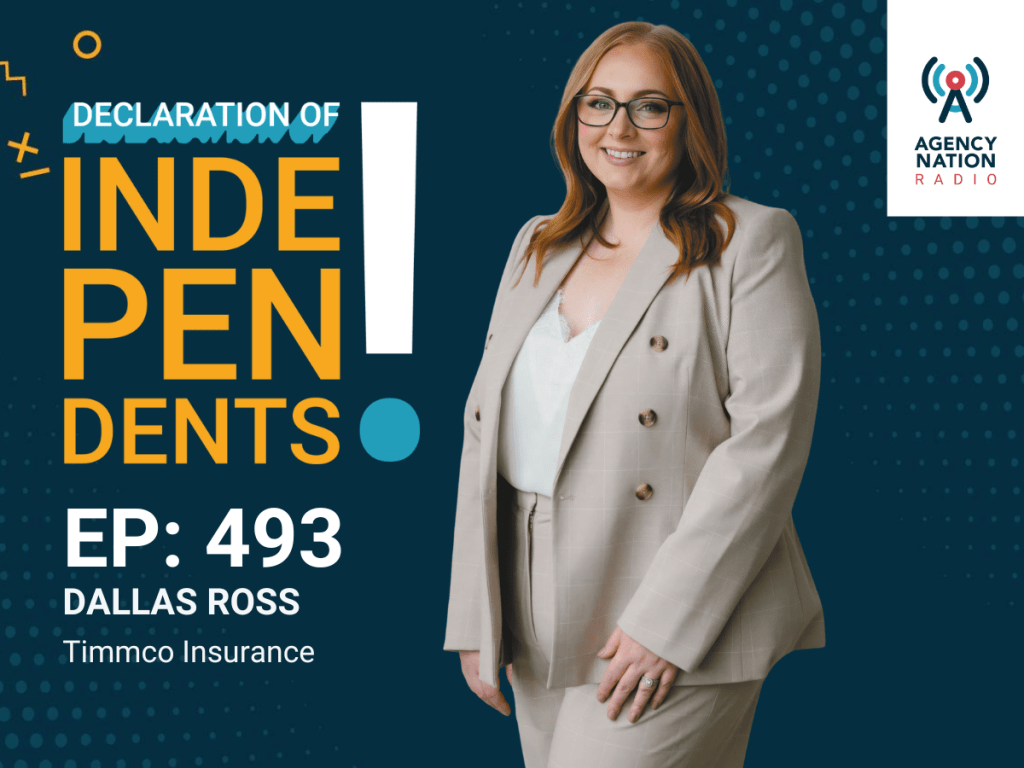Leading Behavior: How to Attract and Retain the Best Talent

By: Will Jones
Ashley Brower-Whitney (below), president at Harbor/Brenn, is a second-generation agency owner and has fulfilled every role at the agency. “I’ve been everything from the assistant receptionist to personal lines agent to commercial lines service and support to operations to sales,” she says. “I’m very familiar with the challenges of the different roles, which I think is needed when you’re trying to manage and lead a diverse team.”
Brower-Whitney has been president of the agency for the last eight years and, as of 2019, is a 50% owner. When she took the reins at Harbor/Brenn, most of the producers had been with the company for 20 years or more and many of the compensation packages were already in place. So when the time came to hire a new producer, “I had to come at compensation differently because it’s very different now than it was 20 years ago,” she says.
Compensation Trends
 Approaches to hiring producers and creating a compensation structure have been relatively unchanged for the past 20 years. Currently, according to the 2019 Best Practices Report, smaller commercial lines agencies pay 40%-45% on new business, while larger businesses pay 35%-40%. For renewal business, smaller commercial lines agencies pay 30%-35%, while larger agencies pay 25%-30%.
Approaches to hiring producers and creating a compensation structure have been relatively unchanged for the past 20 years. Currently, according to the 2019 Best Practices Report, smaller commercial lines agencies pay 40%-45% on new business, while larger businesses pay 35%-40%. For renewal business, smaller commercial lines agencies pay 30%-35%, while larger agencies pay 25%-30%.
Ross Johnson, president of Mountain State Insurance Agency in Charleston, West Virginia, and chairman of the Big “I” Council for Best Practices, has been in the insurance business for almost 35 years and an agency principal for 20 years. “I’ve hired a couple of spectacularly successful producers” and “had multiple failures,” he admits.
In today’s labor market, especially when hiring millennials, “finding someone to work on straight commission is practically impossible, finding someone that’s on an aggressive draw doesn’t seem to work,” Johnson says. “But offering a flat salary with a smaller amount of commission that can be realized at a faster pace than the old draw system does seem to appeal.”
However, when it comes to hiring mature producers, it’s better to offer a more traditional draw, which can be up to 80% of their annualized commission and reconciled every quarter, Johnson explains. “But what we have found with newer producers is that instead of a 40-25 split, we’ll give them a flat salary and then we will give them 20% of new business on top of their flat salary,” he says. “Then, when it’s in their favor to move over to the 40-25 structure, we’ll flip them.”
Producer compensation needs to be “a combination of security and incentive,” Johnson adds. “We try to find the point where the salary is sufficient to cover security, but luxury is dependent upon being successful at selling insurance.”
Bottom Line
When it comes to hiring talent, Brower-Whitney’s main concern is making sure they fit the culture of the agency, which extends beyond sales figures. “If a compensation plan is solely based on dollars and numbers and producers are encouraged to write a certain amount of business, I’m actually hurting my business in the long run because that producer is going to be out there writing every thing possible without taking into consideration whether it’s a good fit with our agency,” she says.
“When everybody we hire and employ understands the value of a client that is open and honest with us and wants to insure their business or their home and autos correctly, I don’t need to incentivize that,” she adds. “Everybody here fully understands the value of that kind of account, and it’s part of our culture.”
Instead of focusing on the results normally measured at the end of the month, the end of the quarter or the end of the year, Brower-Whitney prefers to focus on the leading behaviors that need to happen for those end goals to occur. Examples of leading behaviors include volunteering with community organizations, sending handwritten cards, visiting clients, asking for referrals, writing blog posts and attending local government meetings.
“The result is the sale, the retention and the growth. The leading behavior is the communication, the follow-through and doing business in-person after hours,” she explains. “That’s what I’m monitoring. If people are doing those things, the desired result will happen.”
Harbor/Brenn’s overall culture is underpinned by a “chip system,” which was instituted 10 years ago and has become ingrained in the agency’s culture. Chip-worthy actions include attending a staff meeting (one chip), volunteering during the week (one chip), volunteering over the weekend (three chips) and sharing a synopsis of a self-improvement book they’ve read with the staff (30 chips). Chips can then be used to pay for movie tickets, meals out, time off and more.
“It’s funny because it’s the smallest thing in the world but it’s become such a huge part of this agency,” Brower-Whitney says. “You’ll walk around the office and you’ll say, ‘Hey, that’s chip-worthy.’ There’s something feel-good about it, especially when you get nominated for chips by somebody else.”
Supporting Culture
The leadership at Harbor/Brenn worked hard to create their own culture and “every agency needs to establish their own,” says Susan Palé, vice president for compensation at Affinity HR—a national HR consulting firm specializing in addressing the needs of small to mid-sized businesses and Big “I” Hires partner.
For example, “there needs to be ongoing support,” Palé says. “Employers should be trading in education and all kinds of other support.” This is especially true for new recruits who come into the industry and make immediate progress. However, after they have exhausted their initial leads, they often fade away or are forgotten about because their manager assumes they didn’t need to worry about them, Palé says.
In a business environment where—due to technology and the availability of information—the products are increasingly more complex and buyers are much more sophisticated, “someone new to the business requires more start-up time,” she says. “Talk to your successful agents and find out what helped them, what didn’t help and what they’d like to see done differently.”
“It’s different for every agency because everybody’s recruiting in a different marketplace and recruiting different kinds of people because we’re selling in different markets,” Palé adds.
After spending the first 20 years of his career wearing a suit to work, “I finally got to quit wearing a tie,” Johnson says, who couldn’t have imagined wearing blue jeans to work in the not-too-distant past but made the change to the office dress code “to situational dress to resonate better with young people.”
To attract and retain the best talent, “you have both a robust portfolio of fringe benefits and compensation to compete,” Johnson continues. “We pay 99% of the employee health care and 40% of the dependent health care. I think our people are pretty happy with that. Another thing we do is keep the refrigerator stocked. We have an office food pantry, and we look for opportunities to have catered lunches once or twice a month—we spend around $1,000 a month on food for agency staff.”
“Scheduled flexibility and time off appear to be more important to young people than it is to my generation,” he adds.
“Flexibility is key,” Brower-Whitney agrees. “We have vacation time, but we don’t limit personal time. If you’re sick, your kid is sick or there’s a Halloween parade at your kid’s school, that’s just personal time, and we don’t limit that. Vacation time is true vacation time.”
Diminishing Returns
Creating a perfect compensation structure that encourages growth is “a silver bullet that agencies have been looking for since the beginning of time,” says Tom Doran, partner, Reagan Consulting. “But there are diminishing marginal returns in adding additional compensation and assuming that it will necessarily drive a better outcome.”
“If you’ve hired the right people, you’ve paid them fairly, you’ve created a good environment for them to work in, there’s no objective data that would indicate that paying or incentivizing them with more money is going to materially change the results,” Doran says. “Time is probably better spent on developing systems and a culture that facilitates additional sales—you’re not going to get much more out of a producer by throwing a little bit more money at them.”
Only 34% of sales reps’ time is spent on selling each week, according to Salesforce. This includes the time spent prospecting, meeting with clients face-to-face and communicating with clients virtually. The other 66% of their time is spent on administrative tasks such as lead prioritization, entering customer data into a CRM, researching prospects, generating quotes and preparing for meetings.
Whether it’s prospecting technology, an updated CRM or other internal tools, investing in these resources is generally a better use of agency funds to boost growth, as well as create a structure that enables sellers to sell and other employees to take care of claims, loss control or account management.
However, employing support personnel often means that commissions are slightly lower. “Your commission structure should relate to your overall infrastructure and other investments that you’re making,” Doran says. “Let’s get people doing what they do best and get producers producing and support personnel supporting and servicing. You need to pay the producer a little bit less to do so, but that’s how you afford to make those investments.”
Trust and accountability are also worth their weight in gold to help create an environment where a team can do what they’ve been hired to do. “Holding producers accountable for a well-communicated set of expectations is fundamental to building a healthy sales organization and helping producers to reach their potential,” Doran says. “That extends to agency owners, as well,” he adds. “At the best organizations, the leaders lead by example.”
Thanks to the work that Harbor/Brenn has done internally, the agency is an attractive place to work. “We’ve got new employees coming in to replace those that are retiring who are fitting in really well and we’ve got options when we need to hire somebody, which is awesome,” Brower-Whitney says. “We’re focusing on the culture, stakeholder management, employee leadership and growing and developing the people that are here. Everything else comes as a result.”
“We are growing, as well. We’ve had our best couple of years in the last 20. All of those kinds of things come as a result of what we’re focusing on,” she adds. “We’re growing and hitting goals without actually having to focus on growth and hitting goals.”
Will Jones is IA managing editor.
Big “I” Hires has cutting-edge tools to help small to large insurance agencies hire top-performing sales and service staff.
The Best Practices Program provides agents with meaningful performance benchmarks and business strategies curated from the top performing agencies in the U.S.










